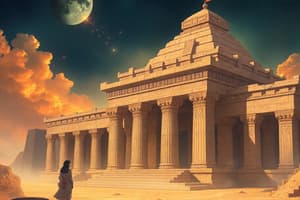Podcast
Questions and Answers
What defines a civilization?
What defines a civilization?
A civilization is defined as a level of development where people coexist peacefully in communities.
What significant event around 3100 BC marked the beginning of preserving historical information?
What significant event around 3100 BC marked the beginning of preserving historical information?
The invention of writing around 3100 BC marked the beginning of preserving historical information.
Name two regions where the earliest ancient societies emerged.
Name two regions where the earliest ancient societies emerged.
The earliest ancient societies emerged in regions like Mesopotamia and Egypt.
What were some common characteristics of ancient civilizations?
What were some common characteristics of ancient civilizations?
What is the significance of the Sumerian civilization in ancient history?
What is the significance of the Sumerian civilization in ancient history?
What agricultural development allowed early Sumerians to establish stable communities?
What agricultural development allowed early Sumerians to establish stable communities?
What writing system did the Sumerians develop?
What writing system did the Sumerians develop?
List one prominent Sumerian city.
List one prominent Sumerian city.
What significant contributions did the Sumerians make to civilization?
What significant contributions did the Sumerians make to civilization?
What characterized the urban development in the Indus Valley Civilization?
What characterized the urban development in the Indus Valley Civilization?
What was the population size of cities like Harappa and Mohenjo-daro around 3300 B.C.?
What was the population size of cities like Harappa and Mohenjo-daro around 3300 B.C.?
Which writing system was developed by the ancient Egyptians?
Which writing system was developed by the ancient Egyptians?
How did the leaders in Ancient Egypt contribute to society?
How did the leaders in Ancient Egypt contribute to society?
What is a notable characteristic of the construction materials in the Indus Valley?
What is a notable characteristic of the construction materials in the Indus Valley?
What medical practice in Ancient Egypt contributed to their understanding of human anatomy?
What medical practice in Ancient Egypt contributed to their understanding of human anatomy?
What technological innovations were present in the Indus Valley civilization?
What technological innovations were present in the Indus Valley civilization?
Flashcards are hidden until you start studying
Study Notes
Ancient Civilizations
- Civilization is defined as communities coexisting peacefully, with ancient civilizations being the first stable groups to lay the foundation for future states, nations, and empires
- Ancient history spans from the invention of writing around 3100 BC for more than 35 centuries
- The earliest ancient societies emerged in various regions, including Mesopotamia, Egypt, the Indus Valley, the Huang He Valley in China, Crete, and Central America
- These civilizations shared common characteristics, such as urban development, the invention of writing, advancements in pottery and metallurgy, animal domestication, and complex social hierarchies
- Knowledge about ancient civilizations is primarily derived from written records and archaeological discoveries
Sumerian Civilization (4500 B.C. to 1900 B.C.)
- Ancient Sumer, located in Mesopotamia, is considered the birthplace of the first civilizations in human history
- The region's "Fertile Crescent," around 10,000 B.C., helped early populations establish agriculture, creating settled communities
- By approximately 4500 B.C., these communities, known as the Sumerians, developed enough agricultural surplus to create the world's first cities
- Prominent Sumerian cities, including Eridu, Uruk, and Ur, featured significant architectural structures such as temples and palaces
- The Sumerians are also credited with the invention of writing, specifically cuneiform, which emerged around 5,000 years ago
- This writing system facilitated the documentation of grain transactions, storytelling, and dissemination of agricultural knowledge
- These advancements earned Mesopotamia the designation of the "Cradle of Civilization."
- Additionally, the Sumerians made significant contributions to mathematics, astronomy, and astrology, developed irrigation techniques, established the first educational institutions, codified legal systems, and created the modern concept of time by dividing the day into hours, minutes, and seconds
Indus Valley Civilization (3300 B.C. to 1300 B.C.)
- The emergence of agricultural societies around 7000 B.C. marked the beginning of small village formations in the Indus River Valley, located in present-day India and Pakistan
- By approximately 3300 B.C., these settlements experienced significant growth, particularly in the cities of Harappa and Mohenjo-daro, which accommodated populations of around 40,000 to 50,000 residents
- Urban development in the Indus Valley is characterized by advanced architectural practices, including the use of baked-brick construction
- The cities were equipped with sophisticated sewer and water supply systems, contributing to their cleanliness and public health
- The layout of the streets followed a strict grid pattern, indicating a high level of urban planning and organization
- The uniformity observed in the construction materials, such as bricks of standard dimensions, reflects the societal emphasis on consistency and order
- Additionally, the Indus Valley civilization is noted for its innovations in weights and measures, which were crucial for trade and commerce
- The presence of a unique yet undeciphered writing system and advancements in metallurgy further highlights the complexity and ingenuity of this ancient civilization
Ancient Egypt (3100 B.C. to 30 B.C.)
- By 6000 B.C., settlers established communities along the Nile, finding refuge from harsh desert conditions
- These early settlements evolved into significant urban centers by 3100 B.C., governed by pharaohs who served as both political leaders and spiritual intermediaries, responsible for law-making, taxation, military endeavors, and maintaining order
- The ancient Egyptians flourished for millennia, gaining recognition for their advancements in various fields, including arithmetic, astronomy, and anatomy
- Their medical practices, particularly in surgery, were notable, with mummification techniques believed to have contributed to their understanding of human anatomy
- Additionally, the Egyptians developed a sophisticated writing system known as hieroglyphics, comprising a vast array of characters used for inscribing on stone
Studying That Suits You
Use AI to generate personalized quizzes and flashcards to suit your learning preferences.



